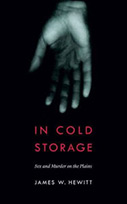In Cold Storage: Sex and Murder on the Plains

Author: James W. Hewitt
Publisher: Lincoln, NE: University of Nebraska Press, 2015. 160p.
Reviewer: Melanie Clark Mogavero | January 2016
In Cold Storage: Sex and Murder on the Plains by attorney, James W. Hewitt, is a chilling account of the murder and dismemberment of a McCook, Nebraska couple in late September 1973. Remains of the victims, 55-year-old Edwin Hoyt and his 56-year-old wife Wilma Hoyt, were found floating in an area lake. McCook resident, Harold Nokes, confessed to the crime and is currently serving a life sentence in Nebraska State Penitentiary. According to Harold Nokes’ formal confession to police, nearly every aspect of the case is implausible, including the murders, the dismemberment, the motive, and those involved. The author, James Hewitt, reexamined this 40-year-old case by reviewing official court documents, including Harold Nokes’ formal confession, media reports, and interviewing law enforcement officials, family members of the victims’, weapons experts, and forensic psychologists. The author intended to reveal what really happened to Edwin and Wilma Hoyt, and more importantly why they were murdered and disposed of in such a gruesome manner. The investigation into the murders unearthed a tale of sexual perversion and betrayal. Hewitt’s investigation of this decades-old murder case is of interest to a vast audience, including historians, those in the criminal justice or psychology fields, and the general public who enjoy reading true crime stories.
The first part of the title, In Cold Storage, refers to where the body parts of the victims were stored after they were killed and dismembered. According to Harold Nokes’ confession, both he and his wife wrapped the body parts in freezer paper, sealed them with masking tape, and stored them inside a freezer in the basement of their home (because of Ena Nokes’ participation, she was arrested and convicted of wrongful disposal of dead bodies). The second part of the title, Sex and Murder, refers to a salacious three-way affair between Harold Nokes, his wife Ena, and Kay Hein, one of the daughters of the victims’. When the three-way affair ended, tensions and emotions between the triad grew, and according to the Hewitt, was the motive for the murder of Edwin and Wilma Hoyt. The last part of the title, on the Plains, the location of the murders, is significant because crime in general is a rare occurrence in rural McCook, Nebraska. The local medial sensationalized the gruesome murder and dismemberment that occurred in their small town. The law enforcement officials who worked the case, inexperienced in handling and investigating such crimes, did not question or fully investigate Harold Nokes’ account of what happened or who was involved. The implausible account in Harold Nokes’ confession to police left more questions than answers, and was the reason Hewitt launched his own investigation into what really happened to Edwin and Wilma Hoyt.
Chapter 1 titled, The Place, provides the history and description ofMcCook, the small town in southwest Nebraska with a population of just over 8,000 (1970 U.S. Census). This chapter successfully allows the reader to get “a feel” for what life was like for residents in this small Nebraskan town in 1973. Chapter 2 titled, The People, describes lives of the victims and those who had a key role in the case, beginning with the assailants,Harold Nokes, and his wife Ena. This preliminary chapter contains significant details about Harold and Ena Nokes that explain why Hewitt believes that the murders did not occur as Harold claimed in his confession, self-defense. The information Hewitt provides about the lives of the victims, Edwin and Wilma Hoyt, describe a peaceful and well-liked couple that were unlikely targets of such a violent crime. Again, these details suggest the crime did not occur as Harold Nokes claimed (self-defense). The People also contains details of the life and unstable personality of Kay Hein, the victims’ youngest daughter and the third party in the love triangle with Harold and Ena Nokes. The author interviewed Kay’s older sister, who portrayed Kay as “extremely manipulative.” The details surrounding Kay’s life and her bizarre behavior the night of the murders suggest to Hewitt that she likely had prior knowledge or perhaps a greater role in her parents’ death than what the original investigation revealed.
The subsequent chapters provide details of the events leading up to and after the murders, obtained from Hewitt’s review of original court records, and interviews with law enforcement officials and family members of the victims. These chapters begin to lure the reader into this unresolved case, and leave the reader feeling invested and yearning to know more. More importantly, the unsatisfying case details allow the reader to sense the author’s enthusiasm for uncovering the truth. Hewitt also provides portions of the transcript of Harold Nokes’ formal confession to police. These transcriptions give the reader a sense of the circumstances that led up to the murder, the possible motive, how the murders occurred, the gruesome aftermath, who was involved, and more importantly, who was not involved. After reading these transcripts, it is clear to both the author and this reviewerthat the murder and dismemberment of Edwin and Wilma Hoyt did not occur as Harold Nokes claimed. Why law enforcement officials at the time did not pursue these inconsistencies is a mystery.
The book also contains photographs that give the reader “a visual” of the key participants of the case. The book contains a photograph depicting Edwin and Wilma Hoyt as a smiling and happy couple. There is also a photograph from the mortuary of the grisly body parts of the Hoyts recovered from the lake. Also included is a high school photo of their daughter Kay, a photo of Harold and Ena Nokes when they were under arrest, and photos of both of their small quaint homes in McCook. Included also are photographs of some of the law enforcement officials who worked the case. The photographs seem designed to further the reader’s desire to uncover the truth of what happened to this seemingly loving couple.
Chapter 7, appropriately titled, The Problems, details the discrepancies with Harold’s confession and the particulars of the case. Again, Harold’s implausible account of what happened left more questions than answers for Hewitt. He sought the opinion of a weapons expert, who essentially proved that it was virtually impossible for the murder of the Hoyts to occur as Harold Nokes claimed. Hewitt also sought the opinion of forensic psychiatrist, Dr. Baldwin, for a possible motive. According to Dr. Baldwin, it is likely that Kay’s termination of the affair angered Harold Nokes, and he subsequently transferred his anger onto her parents. He also suspected a shared psychosis between Harold and Ena Nokes or a possible personality disorder, and that Kay’s behavior was consistent of someone with a DSM-5 diagnosis of Bipolar Disorder. 1
Hewitt interviewed Harold Nokes at Nebraska State Penitentiary, the only interview he has given during his more than 40-year confinement. Now in his mid-80s with plenty of time to reflect and plan a story, Harold Nokes provided a different account to Hewitt about what happened. Harold’s recent account minimizes his extra-marital affair with Kay Hein and denies the three-way affair with Kay and his wife. Based on his investigation, Hewitt believed that this affair was the motive of the murder of Kay’s parents. During his prison interview, Harold stated he “blacked out” after the murders and could not remember the dismemberment or disposal of the body parts, but he claimed he could clearly remember his wife was not involved with the dismemberment. Harold’s recent account continues to raise more questions than answers, and is still implausible. Why did he change his story about the affair? Why was he still protecting his wife Ena?
Aside from certain facts of the case, virtually everything about the Hoyt murders remains unsolved. The author’s investigation led him to speculate on what happened. Hewitt believes that Harold Nokes did not murder the Hoyts in self-defense, that Harold’s wife Ena had a role in the dismemberment of their bodies, and that Kay had either prior knowledge or a greater role in the death of her parents. It remains unknown whether or not any of the author’s speculations are true. Both Kay Hein and Ena Nokes refused interviews with the author, so unless there is a deathbed confession, those inquiring may never know the truth.
More than 40 years after the Hoyt murders, the author’s investigation hoped to reveal new information about what happened—specifically, , how the Hoyts were murdered, why they were murdered, and who was involved. Regrettably, Hewitt’s investigation revealed none of the above. Hewitt refers to this in his preface, and leaves the reader to decide for himself or herself what happened. The reader, whom the author lures into the bizarre tale with the desire to uncover the truth, is ultimately left disappointed. The arduous investigation still leaves the reader, regardless of professional discipline, with more questions than answers about what happened to Edwin and Wilma Hoyt in late September 1973.
Melanie Clark Mogavero, Ph.D.,
Assistant Professor of Criminal Justice, Georgian Court University


